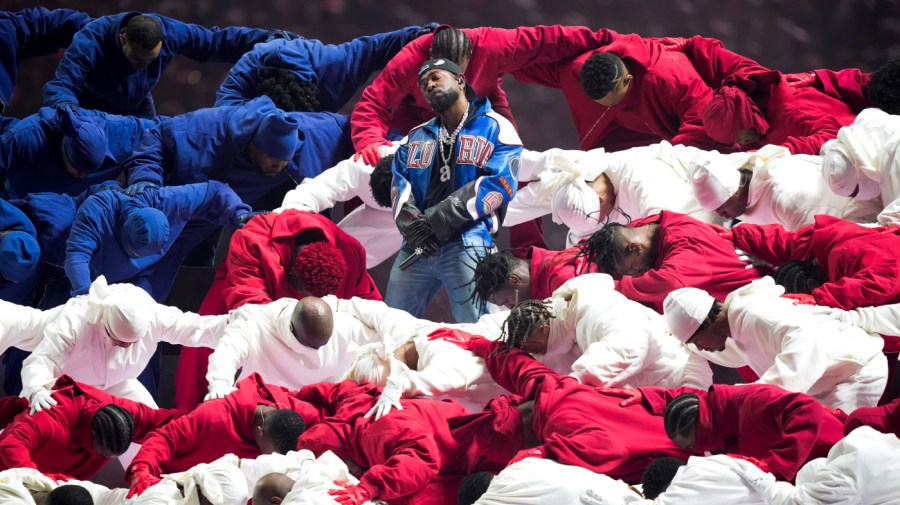
Kendrick Lamar’s Super Bowl halftime performance is growing in viewership hours after the big game, gaining more 11 million views since it aired Sunday night.
Lamar, who has won a Pulitzer Prize, is known for his storytelling, and his performance at the Super Dome sought to tell a story of Black Americans and their place within U.S. history.
While fans gathered in New Orleans rapped along to hits including “Humble” and the Grammy-winning diss-track “Not Like Us,” Lamar’s all-Black performance was filled with political references and Black history.
Here are six hidden meanings in Lamar’s performance.
Uncle Sam / Uncle Tom
The start of Lamar’s performance featured a cameo from award-winning actor Samuel L. Jackson. Known for his comedic timing and especially for his love of dropping the F-bomb, Jackson donned a red, white and blue suit with a top hat to introduce Lamar at “the Great American Game.”
The characterization was one that offered a different narrative of what patriotic Uncle Sam, normally depicted as a white man, looks like.
But as Jackson emcee’d Lamar’s performance, his role took on one of a different uncle: an Uncle Tom.
The term, which originates from Harriet Beecher Stowe’s 1852 novel “Uncle Tom’s Cabin,” refers to Black Americans who turn their backs on the Black community and culture and willingly embrace subservience to White Americans.
Jackson famously took on an Uncle Tom-themed character in 2012’s “Django Unchained.”
At one point during the performance, the actor accused Lamar of being “too loud, too reckless, too ghetto,” voicing stereotypes often associated with Black Americans and hip hop music.
The revolution
Early in his performance, Lamar speaks of “the revolution,” telling the audience that “the revolution is about to be televised. You picked the right time but the wrong guy.”
The line was in reference to Gil Scott-Heron’s 1971 poem “The Revolution Will Not Be Televised,” which argues that change does not come from corporations but individuals, and that the media will not showcase the violence of racism.
But Lamar’s “wrong guy” reference, some social media users speculated, was a direct attack on President Trump, who was in attendance on Sunday.
While Trump won the support of several prominent hip hop artists, including Lil Wayne and Kodak Black, Lamar has been known to criticize the president in his songs “The Heart Part 4” and “XXX.”
Mass incarceration
The set for Lamar’s performance sent its own message. As the rapper and his all-Black dancers spun around the field, it soon became clear they were performing in a prison yard.
The set was designed to highlight the issue of mass incarceration and the racial disparities of those behind bars. Black Americans are incarcerated at much higher rates than White Americans, even for the same crimes.
Though Lamar has never faced incarceration, he often raps about the carceral system’s impact on Black Americans, such as his featured appearance on Beyonce’s song “Freedom,” where he calls for “opening correctional gates in higher deserts.”
Sunday’s performance was not the first live show Lamar has used to highlight the disparities of the justice system.
At his 2016 Grammy’s performance, he dressed in a prison uniform and led a chain gang of backup dancers across the stage as musicians performed in prison cells.
The American flag
Lamar’s backup dancers were dressed in red, white and blue, but if the message of the flag wasn’t clear enough, they came together during “Humble” to form the image explicitly.
At one point during the line-up, the dancers all bent forward, lifting their backs in the air. Many on social media theorized the move was meant to indicate how America was built on the backs of Black Americans during slavery.
Shortly after, the dancers separated, standing in two groups on either side of Lamar.
The image of the divided flag seemed to speak to political divisions around the nation, to which Lamar alludes with the line “it’s a cultural divide.”
40 Acres and a Mule
Ahead of the highly anticipated performance of “Not Like Us,” Lamar raps to his backup singers, “40 acres and mule, this is bigger than the music.”
The line was in reference to reparations promised to Black Americans following the end of slavery.
On Jan. 16, 1865, Union General William T. Sherman’s Special Field Order No. 15 called for each formerly enslaved family to receive 40 acres of land.
The promise was never fulfilled, and the order is often raised in conversations around reparations for Black Americans.
Serena Williams
If fans were surprised to see Jackson join Lamar’s performance, they were shocked when tennis legend Serena Williams took the stage to dance alongside Lamar’s team.
Williams’s appearance was a direct diss to her ex, Canadian rapper Drake, the subject of “Not Like Us.”
But Williams, decked out in a royal blue tennis skirt and matching jacket, didn’t just dance: She was crip walking.
The move, a series of intricate foot movements, was created by the Crips, a predominantly Black gang from Southern California.
Williams, like Lamar, is from Compton, a city with deep hip hop roots. But her performance on Sunday harkened back to her 2012 victory over Maria Sharapova at the Olympics.
The tennis superstar faced major criticism for her dance that year, with some calling the move “tasteless” and “crass” as others accused her of glamorizing gang violence. Supporters of Williams accused those critics of being biased and even racist.
Williams on Sunday spoke of the experience. In a video posted on social media, the Olympian said, “Man, I did not crip walk like that at Wimbledon. Ooh, I would’ve been fined!”












